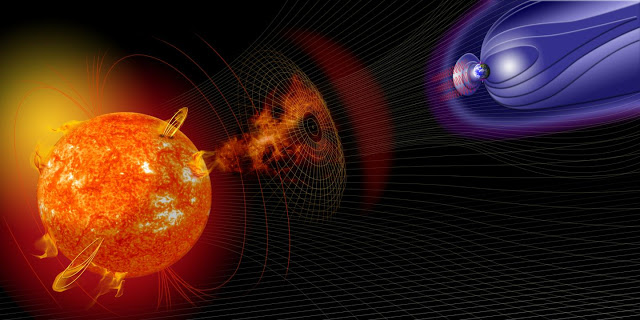| Online: | |
| Visits: | |
| Stories: |

| Story Views | |
| Now: | |
| Last Hour: | |
| Last 24 Hours: | |
| Total: | |
New Tool Could Predict Large Solar Storms More Than 24 Hours in Advance
Coronal mass ejections (CMEs) are eruptions of gas and magnetised material from the Sun that have the potential to wreak havoc on satellites and Earth-bound technologies, disrupting radio transmissions and causing transformer blowouts and blackouts.
These field loops are seen using three overlaid wavelength channels from the SDO spacecraft (171, 193, 211 AIA instrument). The loop structures can be seen to be anchored to concentrated magnetic structures on the solar surface (blue and green highlights seen using SDO’s HMI instrument).
Credit: Dr. Neel Savani, Imperial College London
However, not every mass ejection from the Sun that travels past the Earth causes this much disturbance; the power depends on the orientation of magnetic fields within the mass ejection. Currently, satellites can only tell the orientation of a mass ejection’s magnetic field with any certainty when it is relatively close to the Earth, giving just 30-60 minutes’ notice. This is not enough time to mitigate the impacts on utility grids and systems operating on GPS.
On Jan. 7, 2014, the Sun’s surface erupted with an unusually large explosion, called coronal mass ejection (CME), with NOAA releasing a significant false alarm geomagnetic storm at Earth.

Credit: NASA
“As we become more entwined with technology, disruption from large space weather events affects our daily lives more and more,” said Dr Savani. “Breaking through that 24 hour barrier to prediction is crucial for dealing efficiently with any potential problems before they arise.”
The orientations of magnetic fields within coronal mass ejections depend on two things: their initial form as they are erupted from the Sun, and their evolution as they travel towards Earth. Mass ejections originate from two points on the Sun’s surface, forming a croissant-shaped cloud in between that discharges into space.
This cloud is full of twisted magnetic fields that shift as they travel. If one of these magnetic fields meets the Earth’s magnetic field at a certain orientation, the two will connect, ‘opening a door’ that allows material to enter and cause a geomagnetic storm.
Previously, predictions had relied on measuring the initial CME eruption, but were not efficient modelling what happened between this and the cloud’s arrival at Earth. The new technique takes a closer look at where mass ejections originate from on the Sun and makes use of a range of observatories to track and model the evolution of the cloud.
Dr Savani and colleagues have tested the model on eight previous mass ejections, with the results showing great promise at improving the current forecasting system for large Earth-directed Solar storms. If further testing at NASA supports these initial results, the system could soon be used by NOAA in the US and the Met Office in the UK for geomagnetic storm predictions.
Source:



